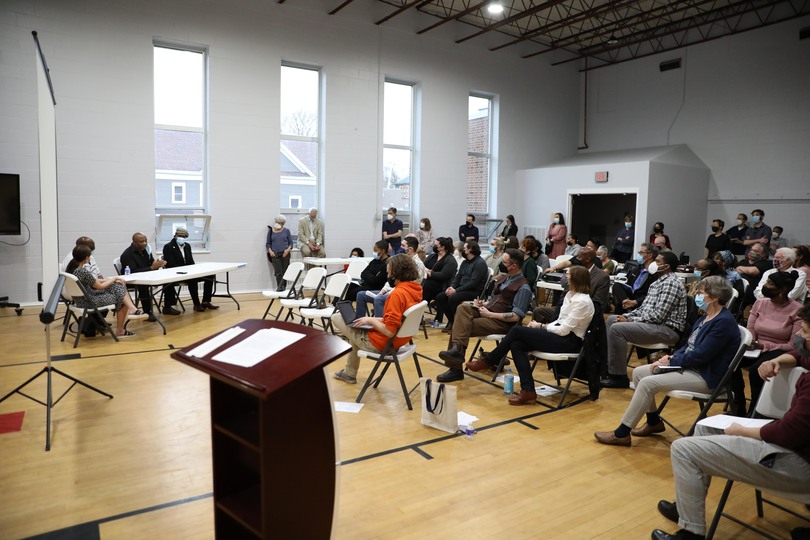Student documentary screening highlights 15th ward destruction, I-81 impacts

Max Mimaroglu | Asst. Photo Editor
“The purpose of this documentary is really to begin a dialogue with all the different stakeholders that are involved with Blueprint 15 and with this redevelopment plan,” Maggie Sardino, one of the documentary's creators, said.
Get the latest Syracuse news delivered right to your inbox.
Subscribe to our newsletter here.
Syracuse University students Maggie Sardino and Mehak Saroha collaborated together on a project for SU’s City Scripts: the documentary “A Blueprint for Re-renewal.”
The 22-minute film, co-directed by the two students, focuses on the history and culture of Pioneer Homes, a public housing project located adjacent to Interstate 81. “A Blueprint for Re-renewal” discusses the once vibrant, predominantly Black community of the 15th Ward that was destroyed by the creation of the I-81 highway during the 1950s and ’60s.
Sardino wrote the documentary, which will be available to the public on the City Scripts website starting May 9.
“We need to listen to the public housing residents and to the people living in Pioneer Homes, Central Village and McKinney Manor,” Sardino said. “I think we all have a responsibility as non-residents of these public housing complexes to listen to them and elevate their voices.”
I-81 has specifically harmed historically Black communities in Syracuse, according to the New York Civil Liberties Union.
Another central theme of “A Blueprint for Re-renewal” includes concern that once the viaduct is taken down, SU and other actors could further gentrify the East Adams community and the rest of the former 15th Ward.
The documentary highlighted SU’s Steam Station, which provides heating for buildings on SU’s Main Campus, as well as SUNY-ESF, SUNY Upstate Medical University, Crouse Irving Memorial Hospital and the Syracuse VA Medical Center.
The Steam Station is just one block away from the Pioneer Homes community, and residents have expressed concerns on how the station affects their health and the air quality of the community.
“A Blueprint for Re-renewal” premiered Wednesday evening at the Dunbar Center. The center has helped impoverished communities since 1918, attempting to narrow the racial gaps created by the viaduct. It provides services including summer camps, programs for the community’s older population and other programs.
Around 50 people attended the screening. The engagement from the community was a step in the right direction, Sardino said.
“The purpose of this documentary is really to begin a dialogue with all the different stakeholders that are involved with Blueprint 15 and with this redevelopment plan,” she said.
Blueprint 15 was the main organization featured in the documentary. According to the documentary, Blueprint 15 is advocating to modernize the historic 15th Ward through initiatives striving for higher quality housing, effective education and promoting the health and wellness of the community.
Raquan Pride-Green is the executive director of Blueprint 15. Pride-Green told The Daily Orange the goal of the organization is to give more power to the people impacted by I-81.
“Our efforts are to ensure that residents have a voice,” Pride-Green said. “We offer them the opportunity to have a voice. They have to take the opportunity to have a voice.”
Blueprint 15 is unique in that it offers jobs to residents who participate in and speak out for the community, Pride-Green said.
“Most organizations are looking for volunteers, but we are actually employing residents and then giving incentives to residents that participate and use their voices so that we can go back to the table with Syracuse Housing Authority,” Pride-Green said.
After the premiere screening of “A Blueprint for Re-renewal,” Sardino led a panel discussion with the Rev. H. Bernard Alex, David Rufus and Ibraheem Abdi. All three of the panelists either grew up in Syracuse public housing or are still living there currently.
Alex is a bishop and senior pastor at the Victory Temple Fellowship Church on the near northeast side of Syracuse. He grew up in Pioneer Homes and said the community still holds a special place in his heart today.
“That footprint of memory that Pioneer Homes has and that community gives to me,” Alex said. “We need to retain (that) memory for generations to come.”

Raquan Pride-Green became the executive director of Blueprint 15 in Nov. 2021.
Max Mimaroglu | Asst. Photo Editor
At one point in the panel, Alex asked members of the audience to reflect on why they were there. Alex said he asks this because he wants progress to be made knowing that the community demands tangible progress.
“This community has been in need for years,” Alex said. “Where have you been? Where was the help 25 years ago? 30 years ago? It has needed this kind of support for years. Let it be from an authentic place and not a ‘we know what’s best for you.’”
Rufus is a member of the NYCLU and worked for the Syracuse Housing Authority from 1976 to 2005. Blueprint 15 offers a platform to members of the community who are too afraid or busy to speak out and remain informed, Rufus said.
“One thing that is critically important is that people have the ability to express their concerns and opinions without any concern,” Rufus said. “Residents in public housing have so many issues to deal with. Shelter, rent, heating, keeping their families safe and keeping the community safe and sanitized. It’s difficult to address the issues when they don’t know where to start.”
Rufus said a major problem with Pioneer Homes and the Syracuse Housing Authority is a lack of connection. According to Rufus, that disconnect and inability to truly care for the residents is creating the problems that Pioneer Homes and nearby communities are seeing today.
“I think that people are being blamed for their condition when it is absolutely the problems with public housing and with the people that are managing that company,” Rufus said. “Public housing administration and officials would rather dig up $800 million to dismantle and destroy this community than find $70 million to help renew it, replace it, rebuild it and modernize it.”
In January, the city of Syracuse announced an $800 million plan to replace older public housing projects, including Pioneer Homes, with a new mixed-income neighborhood. The plan would mark the end of New York’s oldest public housing project.
New York state also recently passed a budget for 2023 that included over $1 billion for the I-81 removal project.
“The legacies and memories of Pioneer Homes have to be remembered,” Rufus said. “We have to teach legacy, not demolition or Section 8 vouchers.”





